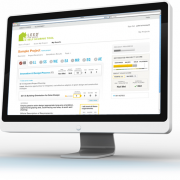More than 10,000 homes across the U.S. have earned LEED certification through the LEED for Homes program, according to the U.S. Green Building Council (USGBC). LEED-certified home projects span the residential market, from multi- and single-family, to market rate and affordable housing.
“Reaching this milestone signifies the continued transformation of the home building industry towards high-performing, healthy homes that save home owners money,” said Nate Kredich, Vice President of Residential Market Development, U.S. Green Building Council. “Market leaders across the production, multifamily, affordable and custom home segments have recognized that there are green homes, and then there are LEED Homes, and they are acting accordingly.”
LEED for Homes is a national voluntary certification system that promotes the design and construction of high-performance green homes that use less energy and water and fewer natural resources; create less waste; and are healthier and more comfortable for the occupants. Since its launch in 2008, 10,161 homes have certified with over 38,000 additional units in the pipeline.
The 10,000th home to earn LEED certification was Tacoma Housing Authority’s 91-unit development, Salishan 7 in Washington. Salishan 7, built by Walsh Construction Company, is the first federally funded HOPE VI Redevelopment project to achieve LEED Platinum. The project was built within an affordable budget, and was designed to be at least 30% more energy efficient than the average home, effectively removing 27 homes from Tacoma Power’s electrical grid.
“We are proud to be a part of the community of over 10,000 homes that have committed to excellence through the LEED for Homes program,” said Michael Mirra, Executive Director, Tacoma Housing Authority. “Our LEED Platinum housing projects are less expensive to operate and are healthier inside, which means a world of difference to our residents.”
Nationally recognized market leaders such as McGuyer Homebuilders, Inc (production homes) in Dallas, Tex., Fore Property (multifamily) and dozens of Habitat for Humanity affiliates (affordable) are just a few of the organizations committing to LEED certification across the country.
Supporting the growth of the LEED for Homes program is the robust and dedicated network of LEED for Homes Providers; a community of nearly 400 LEED AP Homes credential holders, helping meet the need for knowledgeable green home building professionals; and a growing number of LEED for Homes Green Raters. Additionally, the USGBC recently launched its LEED for Homes Scoring Tool for builders to self-evaluate their home construction projects to see how close they are to LEED certification. This simple web-based application makes the program even more accessible to builders and homeowners.
Work with to help make your next LEED project a success.

